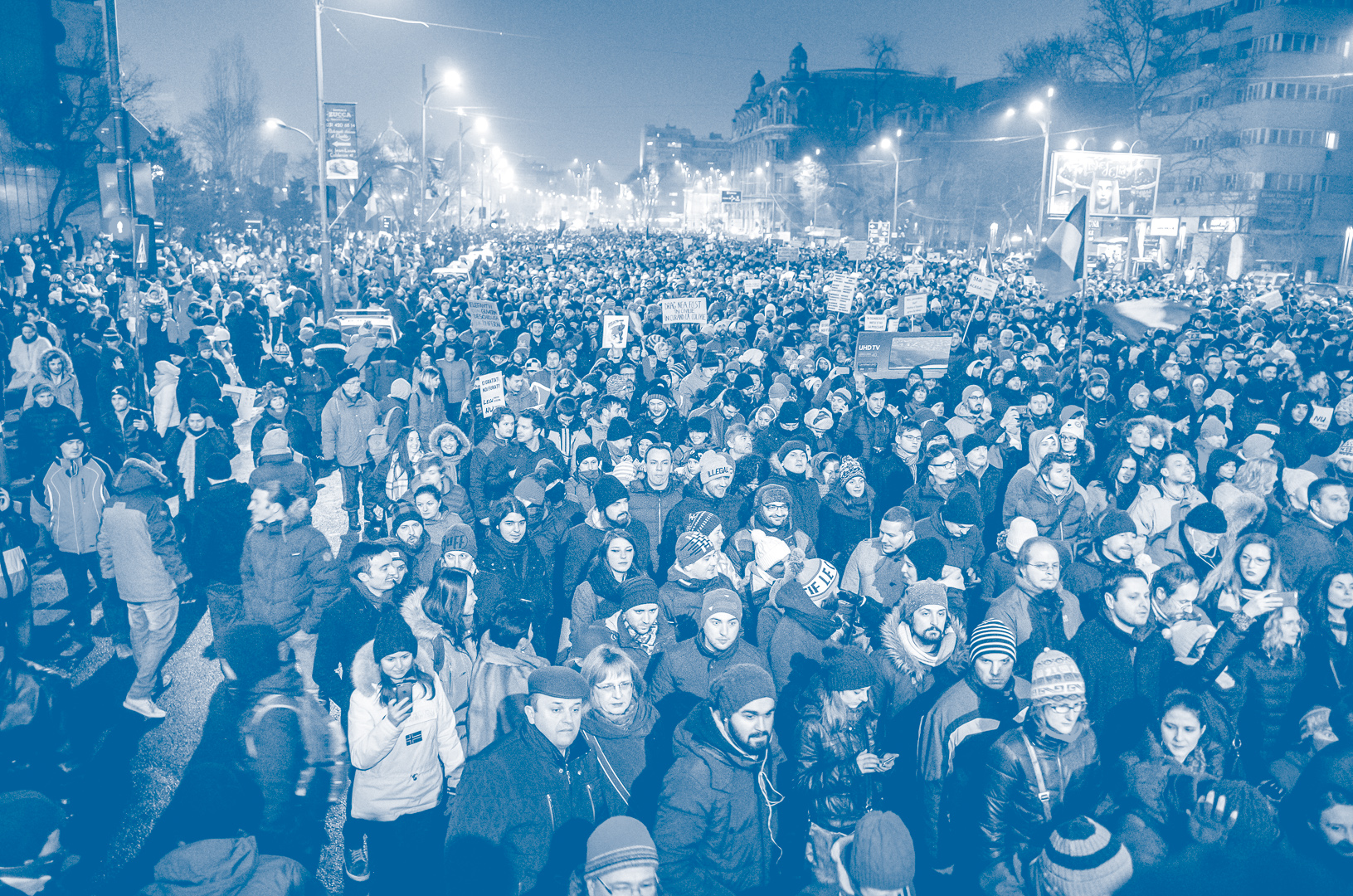By Codru Vrabie | Bucharest
Since the early 2000s, the influential heads of the Romanian executive have attempted to amass more power. Former PM Năstase (2001-04), former President Băsescu (2005-14, especially in partnership with PM Boc, in 2009-11)
and former PM Ponta (2012-15) sought to either bypass the legislature, or to subordinate the judiciary. By trial and error a strategy emerged, to the apparent benefit of the ruling Social-Democrats’ current chairman Liviu Dragnea (since 2015).
The authoritarian tendencies seem to have been consolidated after the parliamentary elections of 2016, with a favorable Ombudsman, and a supportive majority on the Constitutional Court. Depending on the outcomes of the four rounds of elections in 2019-20, Romania
may return to the democratic path, or simply allow the gradual installation of an authoritarian regime from now until 2024. Recently, Romanian MEPs sided with Hungary and Poland, opposing the European Commission’s proposal to cut funding to member states that do not uphold the rule of law (Bayer, 2019).
In November 2018, the political satirist John Oliver dedicated a full episode of his show ‘Last Week Tonight’ to Authoritarianism. In that episode, Oliver synthesised sophisticated scholarly analysis in a list of three broad characteristics of authoritarian rulers – a system of reference as good as any and more user-friendly: projecting strength, demonising enemies, and dismantling institutions. Around the same time, in a TEDWomen talk, the pro-democracy activist Farida Nabourema presented five indicators of countries at risk of becoming dictatorships. These indicators relate to: concentration of power, propaganda focused on ‘saving the people […] from some foreign enemy’, the militarisation or instigation of fear, the suppression of institutions that enforce accountability, and human rights abuses (or ‘cruelty’, as Nabourema put it.)
Pop culture stars, democracy practitioners or theorists (such as Meyer-Resende, 2017; Hopkin & Blyth, 2018; Witte, 2018; Lührmann & Lindberg, 2019; Polyakova, 2019) all seem to be working within similar frameworks. Accordingly, when looking at Romania, they are either surprised at the very slow advancement of the ‘illiberal’ agenda, or remain unclear about the structural differences which may distinguish Romania from other countries. Following the critique in Meyer-Resende (2017) of the term ‘illiberal democracy’, this article looks at the authoritarian tendencies in Romania. Is Romania more resilient than Hungary or Poland? Does Romania really have specific safeguards against various forms of authoritarianism?
The short answer is ‘no’; Romania is not really any different, and has no specific safeguards— indeed, quite the opposite may be true. Given enough time, the current rise of authoritarianism (or of the ‘anti-values parties’, as they were dubbed in Butler, 2019) may bring Romania closer to the results currently seen in Poland or in Hungary—and it should be noted that the neighbouring countries of Bulgaria, Moldova and even Austria seem to be moving in a similar direction. Nevertheless, the longer answer is that Romania does exhibit a somewhat different set of political circumstances. Let us look at three specific factors: the constitutional system, the politicians and civil society.
The Constitution
In Romania, the most toxic instrument of power is the constitutional provision that allows for the delegation of legislative powers to the Executive, in case of emergency (art. 115, §4-6 of the 1991 Constitution, revised in 2003). In practice, emergency ordinances (Romanian abbreviation, OUGs) are an instrument of discretionary power that has been used by all the post-1989 cabinets at a rate that routinely exceeded 100 times a year (or at least once a week, for more than 20 years—see graph). Thus, since this practice of concentrated discretionary power remains largely unchecked and unbalanced, the OUGs alone indicate a clear propensity for authoritarianism in Romania.
The OUGs may not be challenged for legality in the regular system of administrative courts, for they enjoy the same legitimacy
as Acts of Parliament. However, they may be challenged for constitutionality in front of the Constitutional Court (CCR), albeit only if the Ombudsman deems it necessary. About a dozen of the CCR’s decisions (Calistru & Vrabie, 2017) have outlined the conditions and the limitations on the cabinet’s right to issue a constitutional OUG, but the practice continues unabated (11 OUGs were adopted in the first 9 weeks of 2019).
CCR started to behave both like a third chamber of parliament (since 2016), and a mega-Court of Justice (since 2018). Thus, Romania may have lost its most critical safeguard for the constitutional separation of powers, and the cabinet in Bucharest may consolidate its authoritarian outlook.
The very large number of OUGs adopted before 2007 was ‘justified’ by Romania’s process of accession to the European Union. After the accession date (January 2007), the new peak number of OUGs in 2007-2008 was ‘justified’ as a much-needed adjustment to EU membership. Very few of these situations were genuine emergencies, even during the financial crisis of 2008-2010. Nevertheless, the instrument is tempting, and also potentially damaging when coupled with the concentration of powers in the hands of the cabinet.
When both the Ombudsman and the CCR majority are favourable to the cabinet, OUGs are virtually unstoppable as an instrument
of discretionary power. Since the parliamentary elections of December 2016, the Romanian political scene has been shaped
by a combination of like-minded majorities in parliament and the CCR, with an Ombudsman that is supportive of the cabinet. As the Ombudsman is appointed by a parliamentary majority, political power may be concentrated and exercised without domestic limitations (external sanctions from the European Court of Justice in Luxembourg, or the European Court of Human Rights in Strasbourg, usually come too late).
Similarly heightened levels of discretionary power have only been present in Romania once before (and that by accident), in 2011-12;at that time, the overbearing President Băsescu was compensating for a fragile majority in parliament. The key differentiator between the two periods (2011-12 vs. 2017-19) lies in the politicians’ approach to the CCR’s prerogative of solving political conflicts (‘legal conflicts of a constitutional nature’ in art. 146, let. e of the Constitution, introduced in 2003). This particular prerogative comes a close second in Romania’s toxic instruments of power (loosely referred to in Dima, 2015).
As the CCR’s decisions appear definitive and may not be appealed domestically, the natural (albeit defective) tendency was for subsequent Presidents and Legislatures to appoint justices that would secure them a political majority on the CCR. Once such majorities were achieved, the CCR’s decisions began to favour the concentration of power in the hands of the Executive. With only three cases of ‘legal conflicts of a constitutional nature’ in 2012, the CCR’s decisions nudged the concentration of power away from the cabinet (and the corresponding majority in parliament) towards the President. In contrast, with eight decisions in such cases throughout 2017-18, the CCR reversed the balance back towards the cabinet of ministers.
In the process, the CCR started to behave both like a third chamber of parliament (since 2016), and a mega-Court of Justice (since 2018). Thus, Romania may have lost its most critical safeguard for the constitutional separation of powers (see also Vrabie, 2018a), and the cabinet in Bucharest may consolidate its authoritarian outlook. In Nabourema’s words (2018), concentration of power is almost complete, along with the effective suppression of an institution that was called to enforce constitutional accountability. From John Oliver’s perspective, though, projecting strength and dismantling institutions require a little more effort from politicians.
The Politicians
Hollywood wisdom says ‘no villain, no story’. While it is tempting to single out the leaders of the current coalition in government, that would be misleading. Mateescu (2017) describes very aptly the ‘Balkanic Rural-Industrial Communism’ (CRIB) that permeates political action in Romania across all political parties.
Ultimately, what prevents Dragnea from getting his way? In truth, the street protesters, a few civil society organisations, one political party (the USR), the President and the EU/CVM offi- cials have formed a conjunctural alliance that has no actual power.
To over-simplify the political landscape, Romania’s authoritarian forces may be embodied by one individual: Liviu Dragnea, president of the Social-Democratic Party (PSD), chairman of the Chamber of Deputies, and de facto prime minister (ruling through various proxies such as successive PMs Grindeanu, Tudose and Dăncilă.
Along with Călin Popescu-Tăriceanu, president of the Alliance of Liberals and Democrats in Romania (ALDE), and chairman of the Senate, Dragnea maintains a nominal 54% majority in parliament. This majority may increase on some issues, for example upon negotiations for support from the Democratic Alliance of Hungarians in Romania (about 7%); or decrease as some MPs of the PSD-ALDE coalition defect to the newly established (2018) Pro Romania Party of former PSD president and (at the same time) former PM Victor Ponta (2012-15).
With voter turnout at roughly 40% in the December 2016 parliamentary elections, Dragnea’s ability to project strength has some limitations. Inside the party, he promotes only loyalists, disregarding their levels of education, skills or preparedness; he employs the same tactic for any other positions allotted to the PSD by the political algorithm (including most ministers). Outside the party, he employs the OUGs discussed in the previous section. Beyond Romania’s borders, however, Dragnea’s capacity to project strength is limited to a narrow range of parliamentary diplomacy and cooperation.
In the words of Simon Sinek (2009), Dragnea is quite apt at projecting strength at the levels of ‘what’ and ‘how’, but fails constantly at the level of ‘why’. Dragnea cannot articulate an ideology to drive actions; his ‘why’ seems terrifyingly pragmatic.
On the one hand, he fights to avoid being jailed, as he has already been sentenced to two years (suspended), and he may face another sentence of 31⁄2 years (Păun, 2018).
On the other hand, he is closer to an authority figure by nature, rather than to a leader.
The absence of an ideological ‘why’ makes it difficult for Dragnea to appeal to a larger public and amass followers.
For these reasons, Dragnea relies on die-hard PSD voters, and employs strategies that may increase their share in overall voter turnout. Buying loyalties is easy to achieve through OUGs which increase minimum wages at the expense of other economic indicators (national debt, inflation), and this is his preferred tool for projecting strength. Propaganda, spread mainly via TV, attempts to loyalise PSD and ALDE voters (roughly 3.5 of the 18 million potential voters), while discouraging the voters of the opposition parties, along with the undecided and first- timers (to keep the turnout at about 7 million).
Demonising enemies and instigating fear are the tools which achieve both objectives—they enforce loyalties and discourage opposition. Adding insult to injury, Dragnea uses propaganda to fight the judiciary, as this is his most pressing vulnerability. It is thus unsurprising to witness the efforts to dismantle or suppress institutions focused on the anti-corruption prosecution (DNA), the General Prosecution and the Supreme Court. Consecutive OUGs have targeted these judicial authorities, gradually chipping away at their powers since February 2017, with the most notable developments in October 2018 and February 2019, when the Executive attempted to subordinate the General Prosecution to the minister of Justice.
The existing conditions may be ripe for authoritarian rule in Romania, if we consider the constitutional system and the electoral landscape. Dragnea fares quite well on John Oliver’s (2018) characteristics for authoritarian rulers, and may have already checked three more indicators on Farida Nabourema’s list (2018): an attempt (still suspected, not yet proven) at militarisation and human rights abuses, with riot police intervening against protesters (EurActiv, 2018a), as well as an attempt at instigating fear and other human rights abuses with the anti-gay referendum (RFE/RL, 2018).
In the political opposition to these authoritarian tendencies, two actors are worth mentioning, though they both have limited powers: President Klaus Iohannis (installed in December 2014) and a small party – the Save Romania Union (USR), established in 2016, currently holding 9% of seats in parliament). The President may act on three levels to counteract Dragnea’s attempts at authoritarian rule:
– international relations, especially on the EU front;
– procedural battles with the CCR and parliament;
– and media, on the front of public opinion. The USR may act only in parliament and the media, aiming to gather more votes in the next elections.
As early as January 2017, the President advised the cabinet to renounce an OUG aimed at disrupting the course of Dragnea’s pending trials. The cabinet, however, adopted the OUG in February, but then repealed it when faced with mass protests (BBC, 2017). Throughout 2017, the USR employed unconventional tactics in parliament to delay the adoption of legal amendments that would suit Dragnea’s interests directly. The President also played his cards at the CCR, effectively postponing the judicial ‘reforms’ for about a year, until September 2018.
The judicial ‘reforms’ finally came into force in October 2018, through a combination of laws passed by parliament and OUGs decreed by the cabinet. Still, Dragnea’s interests have not yet been satisfied, so additional changes to the Criminal and Criminal Procedure Codes have been planned, to make it more difficult for prosecutors to gather evidence and indict crimes. Such legislative manoeuvres set Romania at odds with the European Commission (CVM Reports COM 851 and SWD 551), the Venice Commission (Opinions 017-e and 021-e) and GRECO (AdHocRep), as well as the European Parliament (Resolution 2844).
Dragnea’s propaganda has received support from the media moguls who had already ‘suffered’ at the hands of the judicial system (corruption charges resulting in sentences of up to 10 years in prison and confiscation of assets exceeding €60 million). TV ‘infotainment’ shows have implied that street protesters, some civil society organisations and the USR are financed by George Soros; portrayed Iohannis as an anti-Semitic fascist and a tax-dodging, greedy landlord; and accused the EU’s Cooperation and Verification Mechanism (CVM) of double standards in assessing Romania’s judiciary.
Despite everything, Klaus Iohannis may win another term in the presidential elections of November 2019, and the alliance which includes USR aiming to win upwards of 15% in the May 2019 elections to the European Parliament. Applying John Oliver’s characteristics (2018) to Romania, it seems that demonising enemies and dismantling institutions are easy to achieve, and they prop up the projection of strength. Yet, the tendencies apparent from Farida Nabourema’s indicators (2018; militarisation, instigating fear, human rights abuses) are even more disquieting.
The Civil Society
Ultimately, what prevents Dragnea from getting his way? (Nota bene the caveat from the previous section: Mr. Dragnea is representative for the CRIB (Mateescu, 2017), a mere shorthand, an over- simplification.) In truth, the street protesters, a few civil society organisations, one political party (the USR), the President and the EU/CVM officials have formed a conjunctural alliance (Vrabie, 2017) that has no actual power. As of February 2019, this informal alliance also seems to include several associations of magistrates which have protested against the latest OUGs directed against the judiciary (Ilie, 2019; Forumul, 2019).
Romania’s civil society has a weaker tradition and notably more limited funding than those in Hungary and Poland. Yet over several years, Romanian civil society scored a series of consecutive ‘wins’ against political power: reinstating a deputy minister (BBC, 2012), stopping the adoption of legislation detrimental to the fight against corruption (Cernea Clark, 2013) and halting shale gas explorations (Cristel, 2013), overcoming nationalist excesses in the 2014 and 2016 electoral campaigns, changing the electoral laws (Pelin & Popescu, 2015), and even achieving the resignation of PM Ponta (formerly of the PSD) in the aftermath of the ‘Colectiv’ fire (Ilie, 2015).
When compared to Hungary or Poland, indeed, Romania displays a different set of political circum- stances, but no specific safeguards against authoritarian- ism – Romania is simply slower to act.
The momentum accumulated during five years of consecutive wins has created an aura of power about and within Romania’s civil society. That aura is a special circumstance that differentiates the situation in Romania, as civil society was able to summon volunteer resources against Dragnea’s authoritarian tendencies. A similar and notable circumstance relates to the USR (created after the 2015 relaxation of the electoral laws), which encompasses a variety of long-time civic activists. While civil society organisations are keeping a healthy distance from the USR, their ideas of good governance and rule of law are clearly represented politically. Without such representation in parliament, Dragnea may have been able to achieve more success, at a faster pace.
In retaliation, the majority in parliament passed new legislation to impede the functioning of civil society organisations and independent media by increasing the bureaucratic burden of reporting their sources of financing (Reich, 2018). Journalists have been harassed with impromptu financial controls by the tax authorities (Insider, 2017), as well as lawsuits that attempted to disclose their sources of reports against Dragnea and his ‘lackeys’ (Benezic, 2018). However, civil society organisations and independent media still resist, possibly drawing upon European values (see Butler, 2019) or, perhaps, hoping to relive the joy of ‘sticking it to the man’ one more time after the 1989 Revolution. The latter explanation seems very much in line with the popular support for Ms. Kövesi’s bid to head the European Prosecution (EurActiv, 2019), after she was ousted from the DNA (Burtea, 2018).
However, this informal, conjunctural and effectively powerless alliance simply cannot prevent the cabinet from adopting any OUG, including the amnesty regulation that would help Dragnea directly (Strupczewski, 2019). The EU has no direct power in Romania’s decision-making, the USR has no clout in parliament, the President cannot block OUGs, the protesters cannot occupy and stop the functioning of all institutions, organisations and journalists are unable to shame Dragnea into halting his behaviour, and the magistrates are ultimately sworn to obey the law. Oddly enough, assuming that Dragnea had no limitations coming from within the governing coalition, the possible explanations are either that Dragnea is still exercising some restraint, or that the propaganda has not yet reached the desired tipping point.
By the same token, the ‘alliance’ is vulnerable in its inability to respond cogently to accusations that the judiciary may have been engaged in abuses against politicians, with undue influence from the domestic intelligence services, at least during 2005-18 (Vrabie, 2018b). Thus, whether demonised or not, civil society is rather ill- equipped to resist the current process of dismantling institutions, and is not yet in a position to offer a viable alternative to prospective good-faith politicians, just in case better times come along. But Farida Nabourema and John Oliver did not cover this hypothesis.
Conclusion
The tactics of demonising enemies and dismantling institutions have converged most harshly on the judiciary. The Constitution has certain weaknesses that allow authoritarian tendencies to consolidate. The possibility of abuse becomes more apparent when the cabinet, the Ombudsman and the majority on the Court belong to the same political coalition—such a situation first occurred in 2011-12 by chance, then was deliberately consolidated after 2016-17. The Romanian drive towards authoritarianism employed this synergy to create a variety of regulations aimed at dismantling institutions that have already been demonised—and the judiciary has fallen prey, bit by bit, despite the process being delayed to the longest extent possible by all the other political actors.
Dismantling the judiciary includes ousting the three chief prosecutors, limiting the abilities of prosecutors to gather evidence and indict crimes, disrupting the course of ongoing lawsuits on procedural grounds, making retirement more attractive for high- performance judges, and undermining the powers of the Supreme Court. Decisions taken by the Constitutional Court (political appointees, political majority) may gradually prevent the Supreme Court (impartial, independent and immovable magistrates) from trying politicians. High-performance judges and prosecutors, disgusted with the political pressure, may simply choose to retire, benefiting authoritarian politicians, regardless of whether they are corrupt or not.
The move against the judiciary was predicated on a breach of trust (and the principles of the rule of law) that goes back at least to 2005, when several judicial institutions started cooperating with the intelligence services. That cooperation has puzzled the attentive public at least since 2015, and was ultimately uncovered in 2018, when suspicions were raised about the convictions pronounced against various politicians charged with corruption.
Such cooperation was sufficient to demonise the judiciary, and to justify (at least in part) the work of dismantling the top judicial institutions.
The OUGs adopted in February 2019 show that Romania’s authoritarian tendencies will not diminish while the country holds the rotating presidency of the EU Council. Hence, one may expect these tendencies to tarnish the electoral campaigns for the European Parliament (May 2019) and for the presidency of Romania (December 2019) as well. Sociological trends suggest that the ‘anti- values parties’ (Butler, 2019) may lose the local and parliamentary elections in June and December 2020 respectively (Mateescu, 2018). However the real danger is that by 2020, the parliament and local governments may be deprived of their powers by means of OUGs.
When compared to Hungary or Poland, indeed, Romania displays a different set of political circumstances, but no specific safeguards against authoritarianism – Romania is simply slower to act. In the period from 2020 to 2028, Romania will have a single (mega-) electoral year: 2024. The obvious danger is that authoritarianism may be firmly consolidated by 2028, or that another violent revolution may ensue. The ‘alliance’ discussed above should seek the political means to amend the Constitution by 2024, to improve accountability in all branches of government, to eliminate OUGs, and to replace the adjudication mechanism for political conflicts. If successful, authoritarianism may be averted in Romania – but that goal may require cooperation, vision and leadership at levels and intensities never before witnessed in Romania.
__
CODRU VRABIE is an activist, trainer and consultant in the field of good governance, with special interests
in anti-corruption/public integrity reforms, both in the judiciary and public administration.




